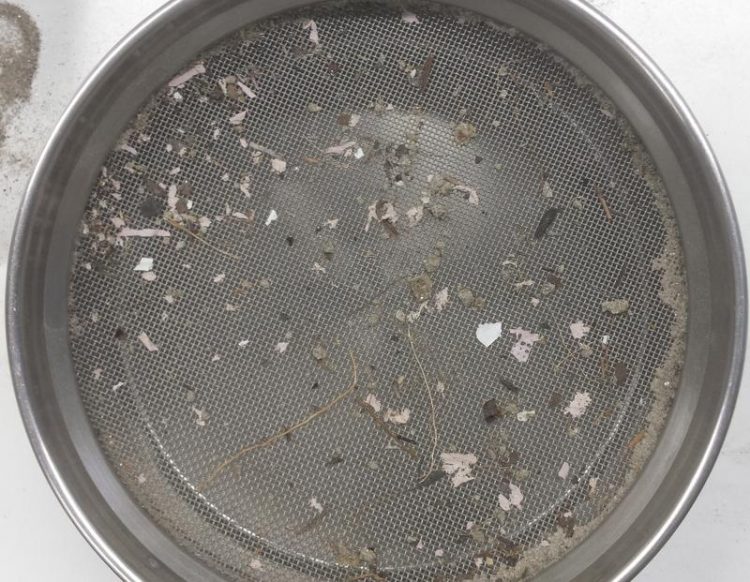Soils in Swiss nature reserves contain significant quantities of microplastics

Large microplastics (1-5mm), mineral particles and plant remains from a floodplain soil of the river Maggia in the Canton of Ticino (Italian speaking part of Switzerland). © Institute of Geography, University of Bern
The images of oceans and inland lakes polluted with microplastics are not new. In contrast, it is almost unknown that even soils are contaminated with microplastics. The problem: Until now, there were no methods to measure and quantify the smallest plastic particles in a soil. The researchers of the Geographical Institute of the University of Bern therefore developed a new method, and for the first time, 29 floodplain soils were investigated all over Switzerland, from Geneva to Grisons.
Almost all nature reserves affected
“Although the sites are located in nature reserves, microplastics were found in 90% of the soils”, says Moritz Bigalke, one of the co-authors of the study by the Geographical Institute of the University of Bern. Even in many remote mountainous areas, evidence of microplastics particles could be found – an indication that microplastics are transported by the wind. The researchers estimate the quantity of microplastics in the top 5cm of the Swiss floodplain soil at 53 tonnes. These results were recently published in the journal “Environmental Science and Technology”.
The largest concentrations of microplastics appear, where larger plastic waste (so-called macroplastics) was found in the soil. Here, microplastics arise, probably due to the disintegration of larger plastic particles. However, microplastics are also found in many soils without larger plastic parts.
These microplastics are extremely fine (< 0.5 mm diameter), have a different composition (type of plastic) in comparison to larger plastic waste, and arise even in some remote mountainous areas. Furthermore, the researchers were able to prove a connection between the population density in the catchment area of the river, which flows through the floodplain, and the concentration of microplastics in the soil: The more people living in a specific area, the more contaminated the soil.
“These findings are alarming,” explains co-author Michael Scheurer, “because new studies indicate that microplastics in the soil can be harmful to and even kill earthworms in the soil for example.” As a consequence, this might compromise the soil fertility, because earthworms perform important duties in the soil.
Effects on plants and food chain unknown
However, the exact effects on plants and soil fertility, and how exactly transport into the human food chain occurs via crop plants, has not been researched. It has been estimated, that the application of sewage sludge to arable land alone, could add an annual MP load to soil greater than that entering the world’s oceans.
So, there is a great need for research in this still new field, as many questions are unanswered. Especially as it is to be assumed, that the microplastics concentrations measured by the researchers in the floodplains, are significantly lower than in other – for example agricultural – soils. Moritz Bigalke says: “So, there is a need for research into the question, of how microplastics affect food production, and whether it can get into the food chain.”
Details of the publication:
Scheurer, M., Bigalke, M.: Microplastics in Swiss floodplain soils, Environmental Science and Technology, 2018, 52 (6), doi:10.1021/acs.est.7b06003
https://pubs.acs.org/doi/abs/10.1021/acs.est.7b06003
Contact persons:
Dr. Moritz Bigalke
Institute of Geography, University of Bern (GIUB)
Tel. +41 31 631 40 55 (in the afternoon)
moritz.bigalke@giub.unibe.ch
Michael Scheurer
Institute of Geography, University of Bern (GIUB)
Tel. +41 79 345 60 52
scheurer.michael@gmail.com
http://www.unibe.ch/news/media_news/media_relations_e/media_releases/2018/media_…
Media Contact
All latest news from the category: Earth Sciences
Earth Sciences (also referred to as Geosciences), which deals with basic issues surrounding our planet, plays a vital role in the area of energy and raw materials supply.
Earth Sciences comprises subjects such as geology, geography, geological informatics, paleontology, mineralogy, petrography, crystallography, geophysics, geodesy, glaciology, cartography, photogrammetry, meteorology and seismology, early-warning systems, earthquake research and polar research.
Newest articles

Superradiant atoms could push the boundaries of how precisely time can be measured
Superradiant atoms can help us measure time more precisely than ever. In a new study, researchers from the University of Copenhagen present a new method for measuring the time interval,…

Ion thermoelectric conversion devices for near room temperature
The electrode sheet of the thermoelectric device consists of ionic hydrogel, which is sandwiched between the electrodes to form, and the Prussian blue on the electrode undergoes a redox reaction…

Zap Energy achieves 37-million-degree temperatures in a compact device
New publication reports record electron temperatures for a small-scale, sheared-flow-stabilized Z-pinch fusion device. In the nine decades since humans first produced fusion reactions, only a few fusion technologies have demonstrated…





















